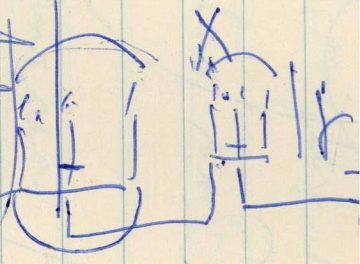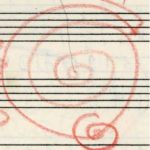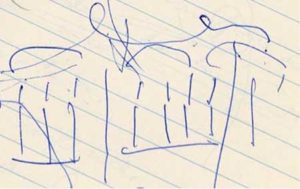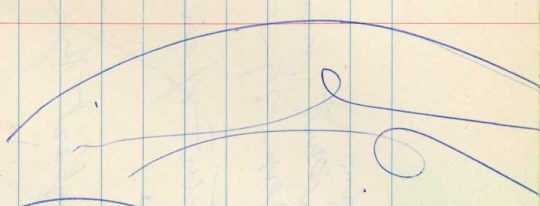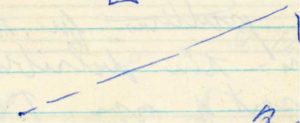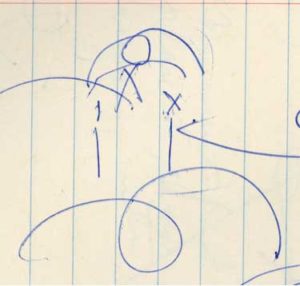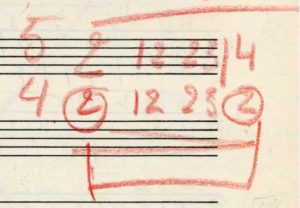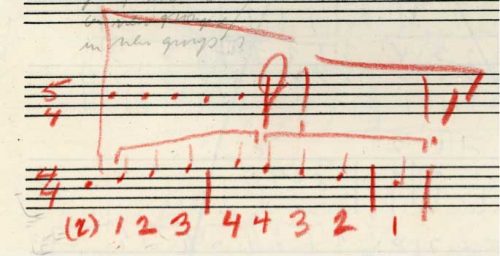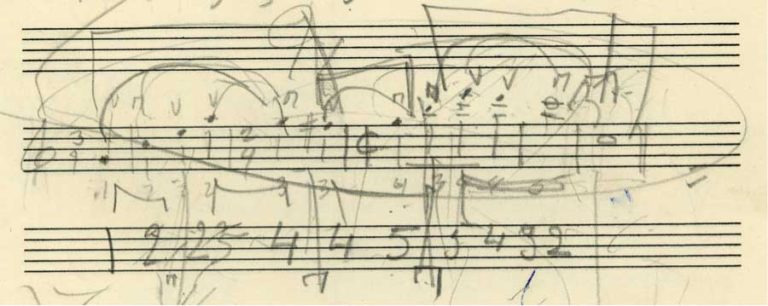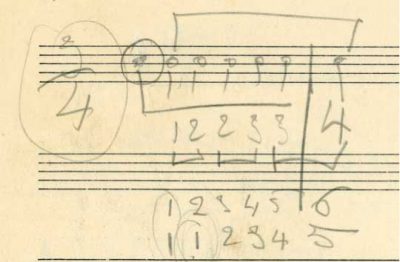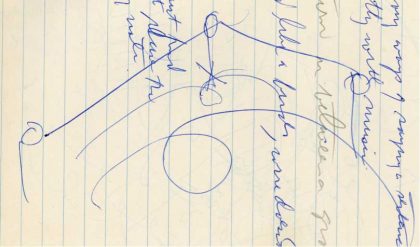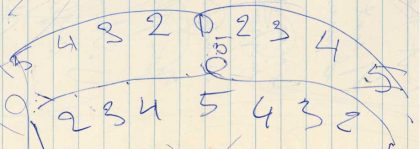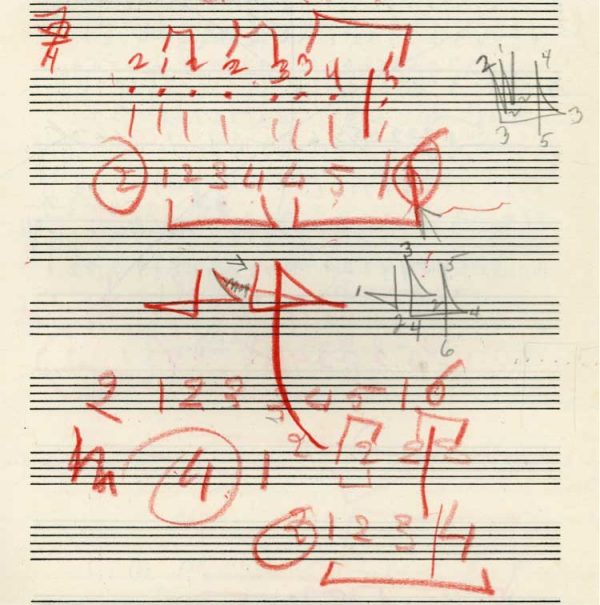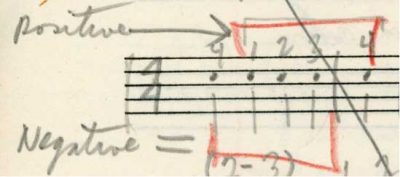Preface by Charles-David Lehrer
It has been some 50 years since the young violist and aspiring conductor, Marc Mostovoy, sojourned to Nice over a period of three summers to study with Marcel Tabuteau. It was during that time (1962-64) that the master took it upon himself, while teaching Marc, to carefully dictate his ideas about phrasing — and about music in general.
It is remarkable, when one thinks of it, that Tabuteau should have entrusted the assemblage of the method he had developed and taught for years in Philadelphia at the Curtis Institute and in his private studio to a mere youngster, who was, after all, not an oboist! No doubt, the universality of Tabuteau’s musical ideas made this possible. Clearly, Tabuteau held Marc in high regard in choosing him to preserve his most salient ideas in writing.
Tabuteau first asked Marc to write a summary essay based on the extensive notes he had taken over the three summers. This was to be followed by a more detailed, expanded version that Marc entitled ‘A Résumé of the Tabuteau System.’ Mostovoy wrote the summary essay and gained his mentor’s approval, but Tabuteau died before having the opportunity to review with Marc the expanded version (typed in outline form) that Marc mailed to him in late December of 1965. Without Tabuteau’s edits, Mostovoy was reluctant to move ahead and publish the document because he felt it was incomplete as it stood. Marc also had concerns as to whether the document he created from Tabuteau’s dictated notes fully captured what Tabuteau intended.
Not wanting the concepts embodied in the ‘Résumé’ lost to history, however, Mostovoy eventually decided to go back to his original notes and publish a transcription of them, letting the chips fall where they may. These notes were to be included in Laila Storch’s biography, Marcel Tabuteau: How Do You Expect to Play the Oboe If You Can’t Peel a Mushroom?, but due to space limitations, only the first seven sections of the complete forty-eight appeared. They are now presented in their entirety, entitled In Tabuteau’s Own Words.
Although there are two extant recordings of Tabuteau demonstrating his ‘method,’ much additional information is included here that should be of interest to a broad range of classical musicians.
Preliminary Comments by Marc Mostovoy
The notes below were written down in longhand at my lessons with Marcel Tabuteau. They capture, in Tabuteau’s own words, his ideas about music. Sometimes he verbalized the same thought slightly differently at subsequent lessons. I have generally included one version or a consolidation, but the words and syntax remain mainly his. French being Tabuteau’s first language, his phraseology was influenced, no doubt, by his native tongue. He spoke English with a heavy accent but his vocabulary was strong and he had no difficulty getting his points across.
Marcel Tabuteau was a uniquely profound musician, performing artist and teacher. At my lessons, his colorful musical explanations were accompanied by demonstrations using his oboe, voice, and animated body language. Because of my string background (I brought my viola to lessons) and interest in conducting, Tabuteau verbalized many of his principles with that in mind.
Some of Tabuteau’s musical concepts are not easy to understand, especially without benefit of his personal demonstrations which helped elucidate things at the time. Since his ideas were expressed over a period of three summers and continually evolving, there were a number of points needing clarification that I planned to resolve with him during the summer of 1966. He also intended to review and provide additional music examples to demonstrate the matters at hand. Alas, he died in January of that year which prevented all of this from happening. For the historical record though, I felt it important to share his ideas as I notated them (including the unresolved issues) in the hope that every musician reading this might glean something of value. This being the 50th year of Tabuteau’s passing, the time seemed right to finally publish them in their entirety.
I want to thank four dear friends whose interest and expertise enabled me to complete this challenging project: Charles-David Lehrer for entering the text into MSWord, inputting the music examples into Finale and PowerPoint, and for working closely with me in finalizing this document; Nancy Bonar Lehrer for sharing her technical knowledge of various computer programs and guiding her husband, Charles, through the minefield of data entry; Laila Storch for sharing with me over the years her own lesson experiences with Tabuteau, thus giving me the confidence to proceed; and Michael Finkelman for continuously prodding me to complete this project, and for his impeccable proof-reading skills. Because of the complexities and exacting nature of this project, their individual strengths proved indispensable. —M. M. 2016
IN TABUTEAU’S OWN WORDS: LEGEND
The numbered headings in BOLD TYPE are my categorizations––an attempt to organize Tabuteau’s thoughts in a comprehensible manner. A Tabuteau quote encompassing more than one topic may be repeated in a relevant section. In lengthier sections, I have introduced SUBHEADINGS for easy reference. Words in parentheses ( ) are also Tabuteau’s from a different lesson; words in brackets [ ] are mine, inserted only for clarification or informational purposes.
The repertoire excerpts are examples that Tabuteau used; non-repertoire examples were inserted by me. The handwritten examples are by Tabuteau entered in the notebooks that I brought to lessons; at times our writings intermingle.
The following letters and symbols are used throughout:
U
=
up
D
=
down
=
up-bow
=
down-bow
R
=
rebound
I
=
inflection
T
=
Tabuteau
The ‘Tabuteau System,’ (his term) is T’s unique method of analyzing and explaining the (very difficult to explain) art of musical phrasing. Relating music to life itself, he first broke down musical phrases into their smallest components and then rebuilt them incorporating special mental techniques to help communicate his ideas. It should be remembered that Tabuteau often stated there can be exceptions to his “rules” even when he says “always.” His concepts should be applied with the understanding that each musical phrase has its own properties. Tabuteau provides the tools to shape phrases logically and creatively, but a knowledge of music as well as sound musical judgment are also needed to fulfill that objective.
In Tabuteau’s Own Words
1. INHALE/EXHALE
It is always two elements which create a meaning. Your line [phrase] is a continuous disturbance of inhale and exhale. Music is living and must breathe.
Everything occurs in pairs: High tide/low tide, day/night, inhaling/exhaling, et cetera; that is life.
2. UP/DOWN INFLECTIONS (impulses)
You can have up inflections and down inflections. Inhales are up in feeling, exhales are down in feeling. Up equals energy—down equals weight.
An oboist always blows out, yet he must make ups and downs.
Downs are heavier than ups. Before you have a down inflection, you should go up.
An inflection up is suspense; when you go up you must come down, unless [you wish to remain] suspended.
Even though the up is more intense, you must make the down sound down. The inflections must be correct: up and down.
Practice up-down and down-up; there’s a world of difference.
Sometimes you have an up and a down [inflection] on [within] the same note.
If you think down on the wrong note, then you are cooked!
Stravinsky, for example, wrote music in complex time signatures and changing ones, so that the up and down inflections fall at the right place.
3. ‘HELPING’ UP/DOWN (for string players)
It is not enough for the bow [just] to go up [or down]; you must help up to be up and down to be down [to effectuate a difference]. Help the bow go up: lift, go up with it.
On a slurred [or tied] upbeat to downbeat,* think up and down and move the instrument [for practice], to show up and down even though the direction of the bow is the same.
4. UP/DOWN BOWING
Whenever possible, use down-bows on downs and ups [up-bows] on up; for example: In 3/4 time the first beat is down-bow and the third beat is up-bow; the middle beat* is your choice.
Change direction with your bow when needed. The point is not whether your down note is on your down-bow, but whether you are changing the bow when you should. This is of extreme importance as it is not good to keep the same direction of the bow for notes that need the bow in the opposite direction.
Rather than having all different [random] bowing [in string sections], have all bow one way [unified bowing], whether right or wrong. [T said he did not agree with Stokowski’s idea of free bowing.]
You can only give and take—you only have ups and downs. You must bridge the gap between an up and a down with your bow [right] wrist; the wrist is the link. Like [using] a paintbrush, connect up and down strokes.
5. BOWING OPPOSITE
Some notes cannot be classed as up or down inflections but feel to the side*—to the left or to the right. North and south are not enough—you must have the east and west.
Ex. 3: Beethoven–Symphony No. 1, second movement.

7. PLACING NOTES
The good musician places the notes on the breath or on the bow; the poor one makes the notes with his breath or bow. Don’t wind or bow your notes! — [a favorite T expression].
Carry your breath through [on an articulated passage]; your tongue moves and articulates the stream of air; in other words, play the notes legato and touch the wind to make the articulation.
Practice the wind first, then place your notes. Always place the note on the line both as far as dynamics and color [are concerned]. (The wind doesn’t change; it’s the mouth [tongue] that works.)
The distribution of your bow is extremely important; place the notes correctly on the bow.
Exercise [Practice] on one note first.
You play your notes against silence, not on silence; you must make opposition.
TIME SIGNATURES
8. UP/DOWN DISTRIBUTION
Play with a continuous distribution of inhales and exhales [ups and downs].
There are many ways to distribute ups and downs. Different forms of music call for different distributions of up and down. In many passages it is possible to have your up and down feelings varied according to interpretation.
Do [Practice] your distribution first with a [tapping] pencil. Practice all the articulations distributing the downs and ups in different places.
FIRST/LAST BEAT
You always have your inflection on the first beat––a down feeling, and always an up on the last beat of a measure; the others can be up or down.
[In 4] You must have a down on the first beat and an up on the fourth beat; if you have a down on the fourth beat and an up on the first beat, then your measure [time] signature is probably wrong.
LAST NOTE
The last note [of a movement] is usually down. [Below is an example of an exception.*]
Ex. 4: Mozart–Symphony No. 39, ending of fourth movement.
THE DOTTED NOTE
A dot is always a down inflection.
TIME SIGNATURES
3/8 [in 1] is a feeling of down|down|down [on each measure], a gallop type of feeling.
In a fast 6/8 [in 2], you always have an up and down inflection [up on 2 and down on 1]; the second beat is up—always. On the second beat you often have a concluding note;* this would be a kind of suspense having a concluding note on an up inflection.
In a slow 6/8 [in 6], you [can] have any combination [of up and down]. If you had a down-up-up-down-up-up|down, it would really be a 3/8 rhythm [Ex. 8e].
Some Examples:
Your downs and ups influence [your interpretation]. 12/8 could be considered, for example, in [3 groups of] 4 or in four groups of 3/8; it depends where the up and down inflections fall.
[T speaking about Beethoven 6th Symphony, second movement 12/8]: Put weight on each beat; a feeling of down, down, down, down—a [slow] gallop type of feeling.
Ex. 10: Beethoven–Symphony No. 6, second movement.
Subdivisions are sometimes necessary; you very rarely, if ever, have in 6/4 for example, down-up-up-up-up-up|down.
In 4/4, you can have down-up-up-up|down, down-down-up-up|down, and down-down-down-up|down. Down-up-down-up|down would really be two bars of 2/4.*
Your distribution—practice down-down-up-up|down, down-up-up-up|down and down-down-down-up|down.
For practice, change notes [pitch] on [up and down] inflection changes.
In 3/4 you can have two feelings—down-down-up|down or down-up-up|down.
BETTER NOTATION
When you have a down-down-up-up|down, you [should] join [beam] the notes as such [Ex. 16a]; down-up-up-up|down would be [Ex. 16b]; and down-down-down-up|down would be [Ex. 16c]; but you always form [carry] the notes [groups] over the bar-line.
IN SLURS
You can’t have down-up-up-up|down on a two slurred-two separate pattern.
Down-down-up-up|down is good (best); down-down-down-up|down is not good (bad).
The articulation three slurred-one separate can be down-up-up-up|down, down-down-up-up|down or down-down-down-up|down.
9. GROUPING/GROUPS
Your arm is made up of many joints, from the joints of your finger to your shoulder; the music is also made of joints or groups. Before you play a line, you must break it up in your mind into small [note] groups and inner [sub] groupings and finally put it together—then you have your arm together.
Your groupings are living and can be expressed as inhaling and exhaling; groups and inner groups make the music live.
A composition [complete score] must be studied thoroughly and each passage grouped correctly.
Grouping depends much on what function
Ta-bu-teau: 2-2-4; Mos-to-voy: 3-2-3; both have eight letters and three syllables but they are grouped differently.
WHY GROUP?
Grouping the right way helps in rhythmic security. [T asked me to insert bar lines in cadenza passages to determine grouping, up-down, etc.] The music will sound more flowing and more together even though the “negative” [as in photography] will be heard by the audience in many cases.
PSYCHOLOGICAL ASPECT
Even though you think of a grouping one way, it can still sound [to the listener as] another; always play the learned [correct] grouping even though it may seem wrong. The audience will still hear it the written way; it’s a psychological change [illusion].
AFFIRMATIVE/INTERROGATIVE
You can break down the groups into affirmative and interrogative in many different respects [ways]. [For this phrase there are 16 possibilities; 6 are shown below.]
WHERE TO GROUP
Always start your groups with [after] the denomination of the time signature, for example: 4/4—4123|4; 5/4—51234|5 et cetera; the inflections determine the measure signature.
In grouping, always count the first note of a bar as an ending from [the bar] before. A grouping usually ends on the first beat of the next measure.
One [The first beat] is never the most important note of a group as it is usually the last of the group before.
Many times a dynamic change falls on the first beat [of a measure] but you can still start the new group on the second note.
Even though the grouping is down-down-up-up|down, you can still group the second down with the following group.
And on a dotted eighth, sixteenth, eighth group, think the first note as an ending note.
Ex. 26c
There are so many ways of grouping some passages; it is left to the choice of the interpreter how to form the groups and inner groups.
Grouping in 5, 6 or 7 can alternate in music. In a 6/4 or 6/8 passage, for example, there are many different combinations; your [grouping] distribution could be very different depending where your ups and downs are: 2+4; 4+2; 3+3; 2+2+2. Always see [find] the root [notes]—the trick [secret] is the distribution.
A 5-beat bar is not written as 3+2 or 2+3 because it is more as one group—not as chopped; yet, a 5 is 3+2 or 2+3.
A 7/8 [bar] should first have [begin with] a group of 3 or 2.
When in 3, don’t group after [beat] 3.
ARTICULATION/SLURS
The form [grouping] has no connection to (nothing to do with) the dynamics and articulation (slurring, et cetera). Slurs are not important; it’s how you group the notes.
The trick and wit is to bow what is written [the written articulation] and yet do the inner work—the grouping—differently.
BOWING
Therefore, if your pattern is like Handel [G Minor Oboe Concerto] you must change direction of the bow, as you need to emphasize the new grouping.* If you play both [the first two] sixteenth notes on a down [or up] bow, they will be of the same group which is not correct.
Ex. 33: Handel–G Minor Oboe Concerto, second movement;
Violin I, measure 6.
PRACTICING
Practice the groupings alone [separately]; then put them together.
Practice [grouping with] separate articulations [first]:
[Then] Articulate the inner groupings:
[And] Then slur:
Get [Practice] groups so that they become natural:
BAD PRINTING
It is a crime the way scores are printed with inconsistent and bad groupings. You must always see [seek] a clue to the right phrasing.
GOAL
Eventually, you combine your grouping—which is related to rhythm—with your coloring—which is related to the melodic line and harmony. Get the right grouping!
10. PUNCTUATION
Music is like a sentence; it has all types of punctuation marks: commas, periods, question marks, exclamation points, semicolons, and so forth. You must use all the right types of punctuation [in music]. It is up to you to decide where the lesser and more important punctuations are. Don’t be afraid to punctuate!
Always group your notes so that the punctuations are right.
[Strings]: You can increase the intensity, take a certain punctuation, and continue the line.
11. BREATHS/BREATHING
When, where and how to take a breath is very important; a good swimmer knows how to take a breath, and when.
Taking a breath on a full comma [semicolon] is not the same as taking one on a minor comma.
Take a breath before the last two notes of the scale, not before the last note.
On a three-slurred, one-separate articulation, take a breath after the third note.
On a one-separate, three-slurred articulation, take a breath after the first note.
In passages with two-slurred, two-slurred articulation, breathe after the first group, not the second.
12. INTERROGATIVE/AFFIRMATIVE
Always be conscious of the interrogative and affirmative [in music]. Find the elements of interrogative and affirmative—question, answer.
It’s not always just interrogative-affirmative; there is also affirmative-affirmative. Always remember there are plateaus in music. You don’t always [just] go up and down a mountain; there are also plateaus.
There are often three elements—interrogative, affirmative, and then an affirmative even more positive. [T speaking about the final movement of J. S. Bach Orchestral Suite No. 2]: Badinarie!—I salute. [Referring to the opening 3 statements]:
Ex. 37: Bach–Suite No. 2, Badinerie.
13. DISSONANCE/CONSONANCE
The position and placement of the chord is very important in deciding whether it is dissonant or consonant in feeling.
A dissonance is interrogative; a consonance is affirmative.
14. RESOLUTION
A seventh chord is always interrogative; the resolution is affirmative.
The dissonant chords are the interrogative; all need resolution.
The leading tone gets more color, but the note of resolution has more weight.
Almost always, notes resolve on the first beat of each measure.
Either resolve on 1 or 3 [when in 4].
Regardless of long or short [note length], you have to resolve the note [requiring resolution].
SHORT TO LONG
The downbeat is longer than the anacrusis [upbeat]; a short note resolves to a longer one. [There are of course exceptions, e.g. the opening of Beethoven’s first symphony.]
The note of resolution is a stronger inflection or broader than the upbeat. Like a [fighter’s] punch—the backstroke (pullback) is shorter and with more tension, but the forward stroke is more forceful and longer.
The short note always resolves to the long even in the Hungarian pattern.
On the Hungarian rhythm, beep—lunge! [T physically demonstrated!]
The trick is to sound as if the sixteenth note is on the downbeat [not an upbeat] the Hungarian way.
15. BAR LINE
The greatest handicap to good understanding [of phrasing] is the bar line; the elimination of the bar line is paramount. Don’t be a slave to the bar line!
16. TO THE DOWNBEAT
Concerning notes leading to the downbeat: The downbeat will be there—don’t worry!–Carry the notes right to the downbeat and [but] don’t fall into it.
Don’t separate the last note [of any piece from the penultimate note]. Pianists do it [when the pitch is the same] because they must lift their hands; make the last two notes together, not just the last.
17. RHYME/RHYTHMIC SECRET
In each piece, movement, or passage, there is a secret of the rhythmic life—the root or the rhyme in the music; you must find it—both the rhythmic and melodic motif.
Whether the notes are faster or slower is of no consequence; there is always the like [similar] rhyme. Use the rhyme pattern of the short notes of a piece to fit the long notes.
18. ROOT NOTES
In a passage, you must decide which [notes] are the root tones [notes] and which are the passing tones. Always play the main or principal notes [first];* that determines the line; the others will fall in place.
Break the line down before you play it the final way.
When practicing a fast melismatic passage, first practice the root notes which usually happens to be the first of each beat.
A root note is almost always the ending note [of a group].*
20. INFLECTIONS (impulses)
Inflections depend much on what function the notes play in the particular key.
Inflections are resolutions of groups. (An inflection is a resolution); they’re the same family.
The inflection is something to be felt inside.
To have an inflection, your preceding note must be an up note.
MEASURE SIGNATURES
The inflections determine the measure signatures.
There is a big difference between [eighth notes in] 6/8, 3/4 and triplets in 2/4; each must get the proper inflection. For example, in 6/8 the fourth eighth note gets the inflection;* in 3/4 the third eighth note gets the inflection.*
FALSE INFLECTIONS
Don’t make false [exaggerated] inflections. The fp or sfz written in Beethoven’s and Mozart’s day are often just inflections but we overplay them. Many markings are unneeded and should be discarded. They wrote sfz and fp for the amateur or ignorant musician who had to be told what to do. The inflection is [should be] felt naturally. In Mozart, the fp is really the [an] inflection.
They sometimes wrote fp and sfz when they wanted you to end a line or have a heavy feeling for ending; but we often don’t take that into account.
[T’s point here is to not overplay fp/sfz, and to able to distinguish between a real fp/sfz and an inflection.]
PRACTICING
It is possible to practice inflections using just a stick rapping on wood; it is a mental process.
21. REBOUNDS
The rebounds assimilate the dance steps —the skips [the bounce in skipping].
A rebound is as if you were walking and you had to change a step, so you hopped and took a make-up step [T demonstrated!].
The rebound is like a billiard ball bouncing off the side of a [billiard] table.
The rebound is the explosion when the rocket takes off.
The rebounds give life to the rhythm—the spark between beats—the bubbles.
A rebound is two notes with no connection. It is a comma in the line, often exaggerated.*
PLACEMENT
The placement of the rebounds is what’s important; you must know where to have [put] your rebounds.
Sometimes you do not wish [to use] a rebound after the first beat of a measure.*
GROUPING
A rebound many times signifies a group change.*
INTERROGATIVE/AFFIRMATIVE
The rebound means a change of direction or a change from the interrogative to the affirmative. It’s often necessary to exaggerate rebounds, especially between interrogative and affirmative.*
PLACID PASSAGES
No rebounds in placid passages! Don’t use them when not needed. If you put them in the wrong place in a placid line, it will sound like choppy water.
Play placid, calm—you don’t have to move all around creation [avoid choppiness]. [This was meant for a specific passage which didn’t require rebounds.]
FOR STRING PLAYERS
Brain [Mental] work plus index finger [pressure on the bow] make rebounds in slurs.
Shifts and changing [crossing] of string should occur on the rebound.
OTHER
You can have a rebound on [within] the same chord.
Very few people know how to treat the tail extension of the first beat note; it is treated as a sort of rebound.*
22. INFLECTION/REBOUND RELATIONSHIP
There is a big difference between a rebound and an inflection.
In a passage, there are notes with inflections, notes that rebound, and passing notes.
Inflections and rebounds are [connected] with rhythm; color is [connected] with harmony.
You can have up inflections* and down inflections,** and up rebounds+ and down rebounds.++ [The sixteenth-note C is a passing note.]
You usually find that the inflection note is an exhale and the rebound note falls on an inhale. An inflection usually precedes a rebound.
A rebound can be like the coming back of the arm for a punch and the inflection being the forward motion of the punch.
Inflections as well as rebounds are an inner feeling.
In 3/4 time [quarter notes], you have two choices: inflection, inflection, rebound | inflection; or inflection, rebound, rebound | inflection.
23. PHRASING
Phrasing is only natural; it follows the laws of the universe (nature) (logic). [T used these three words at different times.]
This system of phrasing is just a concrete way of playing, or saying what the natural [good] musician does.
Phrasing is like a rocket; as it goes up it slows down and makes a turn to resolve.
ELEMENTS
There are five [main] points to think about in a phrase: Up and down inflections; interrogative/affirmative; color; rebounds; and turning points.
Each phrase is composed of its own little groupings, beginnings and endings, ups and downs, inhales and exhales, in either direction.
It is the rhythm mainly that affects the phrasing.
GOING UP/DOWN (in feeling)
In each phrase, you must go up to come down, and down to go up.
Going up: run, it’s more labored; going down: it goes easier, faster. Do the same work when you play [your phrase].
The higher you go [in feeling], the better chance to play [come] down; keep going up-up-up—then down. Take your time when you play [approach] the last note [conclusion]. The conclusion is always down. Prepare the conclusion by going up. You don’t come down before the conclusion.
When figuring out a distribution, sometimes it’s necessary to work from the end to solve the problem.
Practice distributions on your own [self-composed] music [first]; it should precede other people’s [master composers’] music.
CHARACTER
Have a certain character of phrase in mind—it often helps. Even pictorial visions might help.
VISUAL
The line [phrase] is never a curve but loops. Those turns and circles are extremely important.
Ex. 57
LANGUAGE
Music is a language—each note is a word (letter). You must group the words and then the phrase into a sentence. There are interrogative and affirmative phrases. You must have all the right types of punctuation.
There are many ways of saying a sentence. One must be witty in (with) music and say the sentence the right way.
INTERROGATIVE/AFFIRMATIVE
Almost all phrases have the interrogative and affirmative mood—question and answer. There’s always that magic number of 2; it takes 2 to make 1. [T’s interrogative and affirmative indications are circled in red in the example below.]
Ex. 59
Phrases are not always definite or strong interrogative and affirmative. They are like mountains with plateaus: Mountains don’t go straight up and down; there are affirmatives at different degrees and neutral statements.
INDIVIDUAL NOTES
Each note is important (a significance) and must be mentally and physically considered.
Every pearl in a [graded] necklace is a different diameter; so it is with every note. Each note must be measured precisely––graded––as on the small reed-measuring device [micrometer].
ROOT NOTES
Always practice the root [main] notes of the line first; the root notes determine the line. [See Ex. 41a-c.]
NOTE LENGTHS
Take each note as a line, the line being how much of the bow or how much breath you are blowing through [the instrument]. The line going up, for example, would be:
Ex. 60
There’s no excuse for cutting a note too short or holding it too long.
SPACE BETWEEN NOTES
The space between notes is as important as the notes themselves. Changing the amount of space between notes changes the length of each note.
It is space against time––two disturbances against silence that distinguishes the type of note; you must have a measuring point. The space in between tells you what you have.+ The most important note is the second one;* that determines your value.
Place your note on the line [level] of the preceding note.
BEGINNING MOTIF
Many times from the beginning motif, you can figure how to phrase everything else in the movement. Find the rhythmic [and melodic] secret; find the rhyme. [See Ex. 40.]
BEGINNING/ENDING
[In a phrase] The takeoff and landing—how you take off and land––is most important. [T enjoyed watching the airplanes take off and land at the airport which he could see from his balcony in Nice.]
As an airplane, the takeoff and landing is the hardest; in between is easy. The landing [end of the phrase] is always more important.
The trigger makes it start; the distance determines the trajectory [of the phrase].
STARTING OFF CORRECTLY
In all music, a number or letter [indicating where you are in the music] is put at the beginning of a bar;* this is wrong [from a phrasing standpoint]. When playing a phrase, omit the first note when you begin if it is the end of the last group;* don’t start out on the wrong foot even if the rehearsal letter is on the bar line.
Start with the note that begins the phrase,* not the one that ends it.
PHRASING HORIZONTALLY
Even though composers composed harmonically and thought vertically, we must play music horizontally. We must think of each line as a melodic line and phrase them [it] as such, with notes ending on first beats, not beginning on them. If the composer wants otherwise, it will be in the music itself. There are always exceptions to the rules.
Ex. 66: Handel–Oboe Concerto in G Minor, third movement.
You must understand the forms of different types of music [e.g. Baroque dance forms] to know how to interpret it. You must unify [phrase] at the correct places.
GAINING/LOSING SPEED (in direction, not tempo)
You must continually gain and lose speed in music like a rollercoaster; you must know when to lose [pull back] and gain [move ahead] speed.
Don’t start to travel [move ahead] until after the first note [of the phrase].
Your phrasing can be compared to a train; when it starts, the train goes very slowly and has a tight grip on the track. As it gets faster, the train lightens up on the track.
[Strings]: Think of the locomotive picking up speed: A slow bow [to start] and picking up speed with lighter faster bow [strokes]. [Winds]: When you begin a note, your lips are firm, and as the note vibrates more and more, your lips loosen up and the tone is allowed to vibrate freely like a train on a track.
[Phrase] Like a plane: It slowly takes off of the ground and glides up––and vice versa [for the landing].
TURNING POINT
You must know when to change direction in your phrase. There are notes with [which serve as] turning points; between an up and a down [inflection] is a turning point.
Ex. 69
When you change direction [in the phrase], you must go slower [decrease your motion]; a rocket slows down before making the turn downwards. You feel the inflection as less speed at the end of the course. The turning point is often the inflection; the explosion is the rebound.
HIGH POINT/CLIMAX
Every phrase has a summit or climax; always find the high point. Usually you can recognize the note which is the climax of the group or phrase by its longer length or by its position harmonically. Often it is the long[est] note but many times it is not. A note must have length if it is to be the climax of a phrase. If a note is too short, it is difficult to make it the peak. If a note is the most important of a sentence [phrase], it must have value.
The long note [in a phrase] is rarely the highest note [in pitch], yet it is usually the most important.* The highest note is rarely the climax of the phrase as most people believe. Experiment until you find the high point of the phrase.
OVER-PHRASING
In phrasing, don’t “play” your ideas; just think them out in your head and your ideas will be reflected. If you “play” them, the music becomes a parody. (Think it that way but don’t play it that way!)
BE DIFFERENT
[Sometimes] Alter your phrasing so that you don’t do it like everyone else; go to a different [another] point [in the phrase] just to be different.
The phrase doesn’t always have to go to the first beat; do otherwise [another way], but still feel a down on the first beat of measures to avoid ambiguity in meter.
METRONOME
Always practice with a metronome. You can give and take, but make your phrasing fit in [with it]; the metronome is your guide.
Play your inflections and punctuations with the metronome but don’t play as the metronome [a favorite T expression].
Unfortunately many times in recordings, it sounds as if you’re [referring to himself] retarding or accelerating, but it is only an illusion, and the poor student thinks it is right to retard and accelerate.
END RESULT
Once you have the rebounds in the right place, the inflections in the right place and the affirmative and interrogative, you have it made!
24. COLOR (note density/intensity)
Color is with harmony; inflections and rebounds are with rhythm.
To make the music live, you must change the coloring of almost every note.
You can have fortes which mean nothing, and pianos that are bursting apart with color.
ZERO LEVEL
We use the coloring—a mental process—in order not to play on zero level. You must play notes with different colors.
Never play on or under zero level; this is a fault of most musicians.
If you don’t know whether to go up or down in color, do either, but don’t play on zero level.
It is better to go up in color when you come down and vice versa.
LEADING TONE
Use more color on the leading tone.
PITCH
[Winds]: Here is the key—it isn’t enough to make an F and G; you have to think that the G has more vibrations. You must help it and think it higher [in pitch] with more air. The higher the pitch, the more color (harmonics) it automatically has.
[Strings]: As the notes go up, each note must be thought of as being higher. Synchronize the note with its letter name. The right hand [bow arm] responds to the call by varying the bow speed. The higher the interval [note], the more weight and pressure [you apply].
BOWING
The problem of tone color always exists—relation of the bow to the bridge and relative speed of the bow. The distance from the bridge and the amount of hair [used] is color; the speed of the bow is intensity. It is not dynamics; it is the color[ing] of the note. In wind instruments, the pressure of the lips compares to the part of the string where the note is played and the speed of the breath compares to the velocity of the bow.
When you think of changing color, move the bow to and from the bridge; it will be so.
In similar [repeated] passages, vary your bow [position] often.
The bow moves faster on the note of tension. Just moving the bow [faster] isn’t enough for intensity; it must be combined with the proportionate amount of pressure from the [bow hand] index finger.
LONG/SUSTAINED NOTES
A long note cannot stand still [be stagnant]; you must move––it must change color. At the end of a phrase, a large section or piece, keep the sustained notes alive.
Some long notes are more placid [less active].
When a long tone starts to die, give it a little vibrato.
REPEATED NOTES (same pitch)
When there is a repetition of note, the second must get more intensity (more speed) or more color to be heard as separate; the more repetition, the more intensity. They [The notes] must not remain alike.
COLOR/GROUPING
Now we should combine density [color] with groupings; aim for the fusion of grouping and color.
Get [Practice] groups and color so that they become natural. Distribution—color!
25. NUMBERING SYSTEM
[T used numbers as a vehicle to demonstrate many of his ideas and to help solve musical problems in various areas.]
There are numbers for grouping and other things [in music]. Numbers are the answer to many problems—an artificial way to help determine things.
Numbers are [show] color, rebounds and grouping.
The numbering of groupings depends solely on the rhythmic structure; the coloring of each note depends on the melodic and harmonic structure.
COLOR
The color shall be indicated by the numbers. [The higher number means more color, the lower number means less color]. Shoot for different colors.
Numbers are your inner self; you give more from within.
A [single] note could contain one or more numbers [of color].
You must vary your numbers with the feeling and direction of the melodic line.
It isn’t enough to play F and G and [with] the difference being only the physical reaction of the instrument; you must think of the G having more vibrations and therefore more color, in other words your numbers [must reflect this].
DYNAMICS VS. COLOR
The numbers we use are not dynamics; the numbers are colors. The higher number does not necessarily mean a higher dynamic level. You can have your numbers increase or decrease on a diminuendo or a crescendo. The numbers can go up (you can go up in color) and a diminuendo can take place at the same time.
The thinking up of a diminuendo and forward with a crescendo have nothing to do with the numbers. You can go up or down [in your numbers of color], but when there is a diminuendo, go [think] up.
BOW SPEED/POSITION
The numbers are not dynamics; they refer to the [position and] speed of the bow in relation to the bridge. As the number of color increases, come closer to the bridge or [draw a] faster bow. Practice higher numbers on lower notes and vice versa.
RANGE
You have a range of twenty-five or so numbers, but instead of continuing one after the other [until you reach twenty-five], take nine or ten at the most, and transpose it on different dynamic levels. Your numbers will be at different levels according to the dynamic level you are playing in.
Ex. 72
UP|DOWN
3|2 and 3|4—both are up|down, but one recedes in color, the other increases.
You must often play an up|down where the numbers are 2|1. Even though the up is more intense then the down, the inflection must be correct—up and down.
It is possible to have a 6 to a 5 upbeat to downbeat and [still] be heavier on the 5 because it is a down inflection; downs are heavier than ups.
1-1-2-3|2: Practice coming down on [the second] 2,* yet lighter [less color].
INFLECTIONS
A change of number indicates an inflection where needed; not all changes are inflections.
An inflection is not a repetition of number, a passing note or inhale; it is the resolution of a group.
The important inflection of notes does not necessarily have to be the higher number.
When you start practicing a passage, practice everything on “1” [one color] with inflection and articulation.
CONCLUSIVE ENDINGS
When you have a down concluding note [of a group], it is often not necessary to increase your number. The fact that it is a definite conclusive down, you can decrease the number and it will [still] sound concluding; numbers can decrease and still be a conclusion.
When a more definite conclusion is wanted at the end of the phrase, increase your number of color, and when a lighter more indefinite conclusion is wanted, decrease the numbers. A higher number at the end means a more conclusive ending. 3|4 is more conclusive than 3|2. In a 5/4 [measure] 2-1-2-2-3|2 would not be an end; 2-1-2-2-3|4 would be an end.
Ex. 74
AFFIRMATIVE/INTERROGATIVE
Usually, if the phrase is affirmative, the numbers increase, and if [the phrase is] interrogative, they decrease. (Affirmative—increase; interrogative—decrease.)
ASCENDING/DESCENDING LINE
When your melodic line is going up, your numbers should also go up, not down, and vice versa.
When ascending, you usually have an increase [of number] on the [first note of the] bar, but you may have otherwise [a decrease in number] in some instances, especially in building great suspense and vice versa
When numbering a group [in an ascending pattern], the number following the first note [of the measure] must either be the same or below—not above—and vice versa in descending patterns.
Ex. 75
[Sometimes] You must have a pattern going up when the melodic line comes down.
CLIMAX
Your numbers of color ascend or descend according to where the line goes; they ascend towards the climax and descend going away from it.
When you are reaching towards a climax, you higher [raise] your numbers slowly but surely, for example 2-1-2-2-3|4-2-3-3-4|5-3-4-4-5|6 et cetera and vice versa.
Ex. 76
Get [Play] the like [number] pattern on long notes as in the moving passages.
CONCLUDING NOTES
At the end of a phrase on a long note, you must move [increase/decrease your numbers]. When you have a long note concluding, come to it decreasing in numbers so that you can increase color [on the long note]; you have to come down in numbers in order to go up. [See Ex. 78 above.]
SMOOTH LINE
The numbers are related to the melodic line to keep the line (curve) smooth. Except under a few [rare] instances, when changing numbers, do it only by one and not more to keep the line as smooth as possible.
Ex. 79
On a repetition of number, the second note is more intense; more speed.
You very rarely, if ever, lower a number in a grouping when ascending other than after the first beat and vice versa; you will get repetition [of number––See Ex. 75].
REPEATED NUMBERS: INTERROGATIVE/AFFIRMATIVE
The same [repeated] number can mean the change from interrogative to affirmative.
REPEATED NUMBERS: REBOUNDS
When you see two numbers the same, they are like rebounds; you never have the same number over the bar.
It doesn’t make such a difference whether your numbers go up or down as much as where your rebounds [double numbers] are. The placement of the rebounds is what’s important.
When you repeat a number, your rebound is like a ball rebounding on a pool table.
After a rebound, or a change of direction, don’t repeat [your number again].
A double number isn’t the only time you will have an inflection and rebound.
REPEATED NUMBERS: BACKBONE/FORM
You must keep your color the same sometimes or the line will be without form; you must use some repeated numbers to give the phrase backbone. If you change [a number on] every note, there is no backbone or form.
A group of notes can have many different number combinations but they cannot [constantly] skip around; they [the numbers] must be next to each other [contiguous].
Ex. 83
REPEATED NUMBERS: ZERO LEVEL
Never play on zero or mark time or repeat numbers. Avoid repeating numbers like 2-3-3, 2-3-3 et cetera; it is not too good—you’re playing on zero level.
RECURRING FIGURES
Sometimes if you have a reccurring figure, you can make changes of color, in other words 2-1, 2-3 such as in Brahms Fourth Symphony; carry on the dialogue—every group: 2-1, 1-2; question and answer.
Ex. 84: Brahms–Symphony No. 4, first movement.
GOAL
So, we have the system of numbering of color with rebounds, inflections and notes being given special attention; we must combine all this into one.
NUMBERS FOR GROUPING/DISTRIBUTION
In difficult rhythmic passages, the use of numbers for distribution is the answer.
The numbering of groupings depends solely on the rhythmic structure [of the phrase].
Numbers for grouping: 1-2-3-4-5 equals placid; 1-1-2-2-3 equals rebounds.
Ex. 85
When a number is repeated, a new group starts. If there is a change of number, you don’t have a group change except after the first note of a measure. [See Ex. 75.]
You can have many notes falling under one number category.
PATTERNS
The use of numbers on difficult patterns is always the answer.
The key to even counting of 2,3,4,5 and 6 beats to a bar consecutively: 2, 1-3, 1-2-4, 1-2-3-5, 1-2-3-4-6, et cetera. [Each measure gets one beat; the beat stays constant; six beats in total in this example].
In fast runs with many notes, gallop like a horse. Use numbers like 1-1-2-3-4-3-4-5-6-7-8-8-7-8-9 or 2-3-4-3-4-5-4-5-6-7-8-8-9 et cetera; you can backtrack your numbers and continue.
Find the rhythmic counterpoint; find the rhyme; get [look for] the like pattern on long notes as in the moving passages.
Make the music fit the pattern, not the pattern to fit the music.
Practice pattern after pattern; reverse yourself on all patterns. One must practice on simple and then more advanced patterns for three or four years; the distributions will be become a part of you; then apply them to the pieces of Bach, Mozart, et cetera.
26. DYNAMICS
The dynamics are associated with the harmonic structure [of the phrase] and have no connection to groupings, color, articulation, et cetera.
Many times, a dynamic change (a forte) will fall on a first beat [of a measure] for harmonic reasons––suspense [drama], but still the new group begins with the second note. The forte on the first beat is often meant as an ending note, not a beginning note. [See Ex. 24.] Also, the first note should be taken not as a blast, but treated conservatively.
FORCING
Get [dynamic] range without force; you cannot force.
Do not make a harsh tone when playing loud; just colorful—alive. It’s not volume—but the giving of inner wealth.
BIG TONE
A big tone comes [develops] from a small tone.
[Oboe]: You must have support—the reed against the bottom lip, not just suspended. I get my big tone from the position—the angle of the oboe and reed against my lip.
LOUDNESS
Don’t drive with your foot on the accelerator [play loudly] all the time as most people do.
[Winds]: Once in a while, you give a good blow, but not all the time; be particular on the note you give. Kick a note once in a while and drive [your phrase ahead].
You can have fortissimos which mean nothing and pianissimos that are bursting apart with color and vice versa.
Just like blowing the flame of a candle, you have to work harder bringing the flame back [to its original position]. It’s harder to play softly; it takes more energy.
PLAYING LIGHT
Play light and sparkling, not drab and sluggish.
DIMINUENDO/CRESCENDO
[Oboe]: You must think the diminuendo as lighter than air—more lips and less wind, and go up [in thought]. The lips are firm—then loosen as the tone continues so that the tone can vibrate.
[Strings]: On a diminuendo, the bow moves faster in proportion.
With a diminuendo, think up—never down or pulling back. A diminuendo always goes up in your thinking like the smoke of a good cigar; then, if you wish, you can go down afterwards. Learn how to think.
In a crescendo, you move forward or press ahead—not up, down or backwards.
Often when the notes go up [in pitch], do the opposite—make a diminuendo; and when the notes go down [in pitch], make a crescendo.
Stoky [Stokowski] made increases [crescendos] with drums; [strings] do it with the bow.
27. SLURRING/SLURS
Slurs determine, to a certain extent, your ups and downs [inflections].
Slurring makes no difference as to grouping.
When two notes are slurred, only one is [really] slurred; the first one is separate.
Don’t use slurs to express the right inner groupings—it’s too commonplace that way—although every once in a while it’s nice to do so.
FOUR NOTES SLURRED
[Winds]: Sometimes in a continuous four-note slurred passage, you have to break the slur [to breathe]. Wait until you get a strong note [harmonically] on the last of the four slurred tones or break the articulation in a good place.
TWO SLURRED–TWO SLURRED
In passages with two slurred-two slurred articulation, breathe after the first group, not the second. [See Ex. 36d.]
TWO SLURRED–ONE SEPARATE
In triplet figures and also in 6/8 [3/8 etc.], think when slurring two notes: ti-long ta|ti. Always make the second note long; the ta resolves to the ti.
Ex. 89
TWO SLURRED–TWO SEPARATE
When playing a two slurred-two separate sixteenth note articulation, you must think of the first two notes as one note. First play an eighth note and two sixteenths which is the root.
Only one note is [really] slurred; don’t cut off the second.
For a two slurred-two separate articulation, think ti-long ta ta|ti. For the third and fourth notes, long-short|resolve, is better than short long-|resolve. Your second ta should be touched and not as long as the first ta. You must scale the second ta not to be too short as to seem like a punctuation, but to be of short enough length to feel it lead directly to the next note.
In a two slurred-two separate articulation, you rarely, if ever, group after three [the third note]; you always carry the group over to one, even though you could possibly have slight rebounds between three and four [the third and fourth notes].
28. NOTE PREPARATION
Get ready from the preceding note before playing the next note. Once you play a note, your mind must proceed to the next [note]; it’s too late to think about that note [you’re already playing]. Think before you play the note, not after; always look ahead. Always bring the note you are playing to the level of the next one in your thinking.
29. SMOOTH LINE
Don’t let any note become an explosion; do not distort the line. You very rarely try to make a see-saw; the object is to make as smooth a curve as possible.
30. WIDE INTERVAL SKIPS
Widely-dispersed (Jagged) melodic lines must be brought on level; you must think of the notes as on a straight line.
Think (Play) all the notes in between the big intervals.
When in a line [phrase], a note is out of proportion tonally—higher or lower— [a large interval skip] you must adjust [compensate for] either the going up or coming down.
On big skips coming down, slightly turn and travel up again—a skid. When going up [in pitch] in a scale line and you have a downbeat note many degrees lower, don’t think way down [to it]; go slightly down and loop, and continue up.
Ex. 90
Think opposite: Think high when going low and low when going high.
[Strings]: When playing a wide interval, use more bow speed. The right hand must respond to the call with more pressure, more weight—friction. Fill in the interval gap with the mind and the bow, not glissando or vibrato.
On passages with big skips, play [practice] on one note first.
Practice [various] rhythms at [on] wide intervals.
31. NO SMOKING—NO GLISSANDO [T’s words!]
Violinists [String players], when they have to play large intervals, use a glissando to fill in the space. Don’t! Bring the note into the level of the next. [T was not against some expressive portamento but rather excessive and inappropriate use of it.]
32. HIGH NOTES
You can’t force high notes; you must “turn the screw” in the right direction.
Let the notes play themselves; the high ones—don’t force.
When reaching for a high note, think of going down to it—think opposite.
The higher the tone (note), the more pressure must be used. The more down on the reed your lips come [oboe] and closer to the bridge [strings].
33. SHORT/GRACE NOTES
In slow passages, dots over notes shouldn’t be interpreted as too short; it is all relative.
Short notes usually occur in more rapid passages.
Do not under-emphasize the small [grace] notes, naturally.
34. MIDDLE NOTES
As a rule, you must think of the middle notes (note) of any group as being the most important; they get the inflection because the tendency is to underplay them. For example, in 3/4, the two middle eighth notes; in 6/8 and in 2/4 triplets, the second and fifth eighth notes.
Ex. 91
The second beat* is most important in 3/4. In a group of 4, the two middle ones* are the most important. The two middle notes* determine [the rhythmic character of] the rondo form [eighth notes in 2/4].
35. DOTTED NOTES
A dot is syncop[ation]; lean on it.
The dot is your trigger; aim—fire!
A dot is always a down inflection.
36. NOTE ENDINGS
Taper them; think up.
37. APPOGGIATURA
Put a [little] space before an appoggiatura.
38. VIBRATO
[Winds]: The wind makes the notes vibrate as it gains speed. Vibrato is loops; it gains speed and whirls around. Swirl the vibrato.
[On longer notes] Vibrato shouldn’t begin right away (full force), but builds up gradually.
[Strings]: Don’t make vibrato do what the bow should do; after the bow does the work, then introduce the vibrato.
Unfortunately, vibrato is [sometimes] used to replace the color that should be made by the breath or bow. [In certain passages] Vibrato must be used sparingly.
When a long tone starts to die, or decay, give it a little vibrato.
[For] White tone—give it a shake [vibrato] [to liven it up].
39. TEMPO (pre-Romanticism)
Tempo is something that should have some leeway as to how fast or slow one is to take a piece, but the tempo must be constant once you start.
40. BUILDING UP SPEED
Always practice slowly (in slow motion); that is how you get [build up] your speed.
41. THE LOOP/TURN
The loop [turn] is a time element; you place the note a fraction of a second late (different).
Ex. 93
Your line is never [just] an arc, but always an arc [with loops in both directions, upper and lower]. Those turns and circles are extremely important. Play the note on the loop—on the turn.
Ex. 94
The loops (turns) occur between groups. There could be many notes or one note in a loop (turn).
42. TRILLS
The trills must be written out [to predetermine the number of notes to be played].
43. INNER WORK (nuance)
Never “express” the inner work; feel it.
The trick and wit is to bow what is written and yet do the inner work (the grouping) differently, without needing to change the bow. [See Ex. 32.]
44. PRACTICING
Practice your own [self-composed] music first so that your performance of great music sounds spontaneous and not like an exercise. Compose your own music to practice inflections, groupings, articulations, intervals, direction, coloring, et cetera. After you are proficient, then you apply what you have learned to the music of the masters.
Do [Practice] exercises in every key.
45. CONDUCTING
GESTURES
In conducting, the height of the baton will determine the color, direction or inflection—whatever you desire to call it; dynamics will be controlled by the largeness of motion.
You have two hands, one for beats and color, the other for inflections, smoke and other things. You must decide which is for which, and practice to get them [your hands] to do what you feel.
Many times when conducting a measure signature such as [a slow] 6/8, where there is more than one note to a beat, you may have to conduct or nudge some notes that fall between your beats. It’s good sometimes to subdivide and give each note—when proper and if possible—a stick movement.
In conducting, your baton should move in circles like a snail [shell]; all things are created in circles, like snails.
Conduct diminuendos up like good cigar smoke.
Make your eyes big [i.e. facial expressions] like an actor [to achieve certain moods].
UP/DOWN
You can conduct down feelings as well as up feelings, just like you were bowing a string instrument. For a slurred [or tied] upbeat to downbeat, help the direction in conducting.
On a down feeling, or when the resolution is down, your hand comes down.
On the first of double numbers, the baton comes down for an exhale or finishing note, and the following number (the same number) is the beginning of a new pattern–an up or inhale.
Ex. 95
CONDUCTING OVER THE BAR
Composers composed harmonically—and [many] still do; they think of the vertical harmony. We must think of each line as a melodic line and phrase them as such with notes ending on first beats, not beginning on them. Sometimes [however], a piece is composed by the measure; you must conduct it accordingly.
It takes 3 steps to make 2 and 4 to make 3, et cetera.
When playing or conducting, always start with the denomination of the group you are conducting. In four, for example, don’t think |1-2-3-4|1 but rather |4-1-2-3|4; in three think |3-1-2|3, not |1-2-3|1. [See Ex. 22.]
On a 2/4 measure, as your hand goes down, you say 2 and as it goes up, say 1; the same with other groupings.
BEAT PATTERNS
Sometimes you do not conduct established beat patterns; conduct with up and down inflections in mind. Let the musicians count.
Grouping in 5, 6 or 7 can alternate in music; for example, in 6/4 time, in [within] one passage you could have 2-4, 3-3, 4-2, et cetera. You should not [always] beat it [the subdivision] in the standard 6 [3+3] pattern but in 2+4, 4+2 beat patterns.
After [establishing] your basic 1, 2, 3, 4 beat patterns, all other beat patterns should be placed on it in subdivisions of one of those 4 basic patterns, but divide it [5] 2+3 or 3+2. A 5/4 bar is not written as 2/4 and 3/4 or vice versa because it is less chopped and hangs together more as one unit–a more cohesive feeling, yet still conduct it as 2+3 or 3+2.
Ex. 97 [T showing various groupings in 7 and how to conduct them.]
INFLECTIONS
When the baton comes down, you usually have an inflection. However, in 5, to have a placid beat, |1-1-2-3-4|5, instead of |1-1-2-2-3|4 [with rebounds], you come down without making an inflection. In a placid line, you don’t have much inflection.
Never take the classical minuet in one [trios are often in one]. Scherzos are many times in one, but never group measures because you must have a down inflection on each bar.
The waltz gets a down inflection on each bar.
If your inflections are in the wrong place, you’re conducting differently from what the time signature is.
It is up to the conductor to determine if a sforzando is an inflection or a real sforzando.
Inflections must be felt; rebounds should be indicated.
REBOUNDS
Shoulder the note on the rebound [a quick shoulder motion forward].
DOTTED NOTES
Always beat [conduct] the dots [of dotted notes]; it’s very important.
The dot must not be empty; it should be nudged—shoulder it.
Many times, you come [conduct] up in a circle on a dot.
CUTOFFS
When cutting notes off, cut—as a flower—at the roots, not high up on the stem.
MENTAL WORK
Much of what you are thinking, or your approach to something in the music, will be reflected in your conducting. It does not have to be explained.
Have a certain character of phrase in mind—even pictorial visions; it often helps.
VIOLIN SEATING
The second violin(s) should be in “opposition” to the firsts; they shouldn’t be muddled. Put them on the opposite side. The seconds [violins] should play out [since the F-holes face inwards].
46. OTHER QUOTES ON MUSIC AND PHRASING
NATURAL LAWS
The [Ancient] Greek attitude towards music complies very much with the theory that music follows the laws of the universe.
Music works with the natural laws of nature, not against it. It’s a natural thing—we revolve in circles.
Music is like physics: The notes are different as [inso]far as the number of physical vibrations is concerned. [However,] This is not enough difference; there also must be a distribution of color and inflection. You must fuse the two.
RELIGION
Music is like the Bible—you find new things in it all the time.
Bach’s music is the closest to God.
TRUTH
The truth is always right around us; it is up to us to find it.
LUCK
Don’t play luck—there is a reason for everything.
FUN AND GAMES
Music is like a game; you must try [experiment with] all the [different] ways of playing. You can have fun with music.
TRICKS
The more tricks or tools at your disposal, the better: the more things and combinations to manipulate.
MAKEUP
In music, you must use the makeup of an actor; the more makeup, the more roles and characters he can play. (You must be made up as an actress makes up.)
LOCK/KEY
You need the right (key) (combination of the lock) (dents in every key) to open the door.
[Say] There are five dents in the key now—perhaps [there will be] twenty in many years [as you gain more understanding].
THINKING
Don’t play as you feel—play as you think; when you play with your head, you are playing with your heart. The mind is what works and is reflected in the playing. There are so many things to think about [in music]; learn how to think.
POSITIVE/NEGATIVE (for over-the-bar grouping)
Music is like a photograph; you see only the negative in front of you.
Ex. 98
FOOTSTEPS (for over-the-bar grouping)
Music can be expressed in [foot]steps: The first foot advances, the other foot finishes. When you walk, you can’t take only four steps—you really must take five; you must bring the feet together to complete the action (last step). It takes five steps to make four.
DANCE STEPS
The Russians have the right idea by combining dance with music and their gaiety.
PENDULUM
The pendulum doesn’t stop, but it continues.
Watch the pendulum of a clock; look at the balance. [T’s father was a clockmaker.]
WILDLIFE
Many times you wish to land on a note like a bird landing on a wire without shaking it.
Play like a bird turning on wing.
Don’t fly like a duck but glide as an eagle.
Ride like a horse, not a donkey.
SKIPPING STONE
Watch a stone skipping across the water and the ripple effect it produces. It bounces each time a little less and then sinks. You scale the line like the stone skims the water; play like that.
SMOKE
Like good cigar smoke, the line goes up; bad cigars, the smoke goes down.
CAR
Music can be compared to a car: If it is out of gear, the car does not move; it just makes noise [perhaps T’s favorite analogy]. Keep the music in gear like a car.
RUBBER BAND
The further rubber is stretched, the harder it comes back.
RULES
There are no rules that can’t be broken.
ANOMALIES
The organ is like a comet—it doesn’t belong to our system. [T on a number of occasions mentioned his dislike of bagpipes as well!]
C to E is a third; E to G is a third; together they are a fifth––music’s incongruence––[they should total a sixth].
MODERN TECHNIQUE
Make use of all our modern advances in technique to play the old music. This is only logical. If you have an improvement, use it! [One wonders if T would have approved performing on period instruments!]
INCOMPETENT MUSICIANS
Unfortunately, people [musicians] conform to the technical deficiencies of their instruments instead of overcoming them.
In older days, they [composers] even indicated major and minor for the stupid musicians.
Only a fool accents the downbeats.
47. ON TABUTEAU
The rest [other musicians] are not born [yet]; I’m still on milk.
The conductor knows everything but doesn’t understand anything; I don’t know a damn thing but understand a lot.
Memorizing is bad; forgetting is better so music is always fresh. I try to forget; everyone [else] tries to memorize.
I get my big tone from the position, the angle of the oboe and reed against my lip.
48. FINAL STEP
In the last step—the performance, let the music take you over (get the best of you) rather then giving your best to the music—or better yet, do both! [T emphasized this last step, so that one’s playing would not come across as overly studied, but rather fresh and spontaneous.]
POSTSCRIPT
[T’s premise is that only through creative thinking, detailed analysis and diligent practice can you hope to achieve the highest level of musical performance. All means available must be utilized in service of the music.]
Next Section: Tabuteau’s Influence Beyond Curtis




























